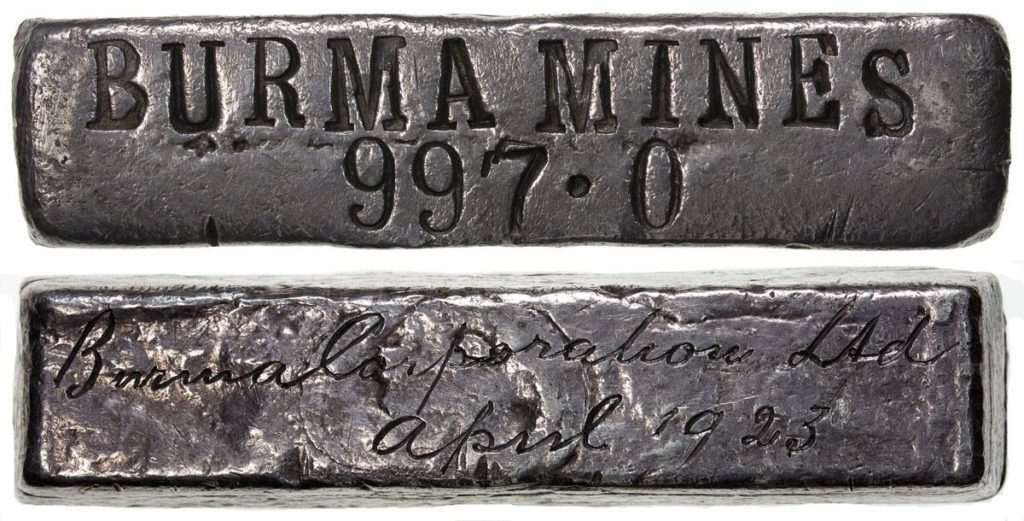BURMA: AR ingot (129.89g), silver, BURMA MINES, April 1923
BURMA: AR ingot (129.89g), BURMA MINES / 997.0 (fineness), hand engraved company name in English cursive script and date, April 1923, very unusual silver bar, VF.
While not strictly a 19th century ingot we recognize the significance of this ingot with a placeholder for the Burma Mines in Burma, Myanmar connected with a former President of the United States!

The following information courtesy of silveringot.info:
Ref: https://silveringotinfo.com/doku.php?id=b:burmamines
Company Name: Burma Mines Ltd, Burma Corporation Ltd.
Company Location: Majority British and U.S. owned, with offices in London and Burma (Myanmar). The mines were located in the Bawdwin and Wallah Gorge area of mountainous inland Burma, East of the Irrawaddy River.
The story of Burma Mines is the story of Herbert Hoover, a young mining engineer who would later become President of the United States. After gaining experience as an engineer and consultant in the gold fields of Western Australia in the late 1800’s, Hoover turned his attention to Burma, where he would later make the bulk of his fortune.
In 1902, the Great Eastern Mining Company had formed in London, and was struggling to build railway and other infrastructure in the Bawdwin area of Burma to salvage huge amounts of valuable lead slag that had been discarded by the Chinese during some 400 years of silver mining. “Bawdwin” means “silver mine” in Burmese. Mismanagement and poor decisions had put the company in trouble, and they turned to Hoover and his current employers, Bewick, Moreing and Company for help. By 1906, Bewick, Moreing and Company had gained control, and the company later known as The Burma Mines was born.
Burma Corporation’s spiral railway rise (Rogers, P.8)
“Hoover and others became dissatisfied with some of the directors and management of the mine, and particularly with Bewick, Moreing and Company. Hoover had resigned from his partnership in that firm sometime previously and felt there had to be a reorganisation. He had calculated an extra £300,000 of additional capital was needed and on 27th of September 1913, he and his fellow financier R. Tildren Smith announced plans to form a new, third, company – the Burma Corporation. Arrangements were made to transfer Burma Mines shares into the Burma Corporation, which would control the Burma Mines. The Burma Corporation was created on 9 October 1913, with authorised capital of £750,000, and within six weeks two-thirds of the shares in the new company had been issued. The largest shareholders were Hoover and his business colleagues, including financier Tilden Smith and some companies in which Hoover had a controlling influence, such as the Lakeview and Star Company and the Intercontinental Trust and other Australian interests. Hoover achieved the dominant position in the new Burma Corporation. In April 1914, the authorised capital was raised to £1,000,000.” (Rogers, P. 10, 11)
“Hoover was already a very wealthy man when the Burma Corporation came into being. He became chairman of the board of directors of the new company and was now poised to make an additional fortune – a tremendous feat for a man in his early 40s.” (Rogers, P.11)
Citations: Rogers, David. Herbert Hoover: From Australia to Burma (2016)
Known sizes: 4.18oz, 5.7oz, 5.87oz (seen by British Museum curator Joe Cribb in 1988), 6.42oz.
[01/2019] https://www.icollector.com/BURMA-AR-ingot-129-89g-silver-BURMA-MINES-April-1923-English-cursive-script-and-date-VF_i32005859 ($1,904)
